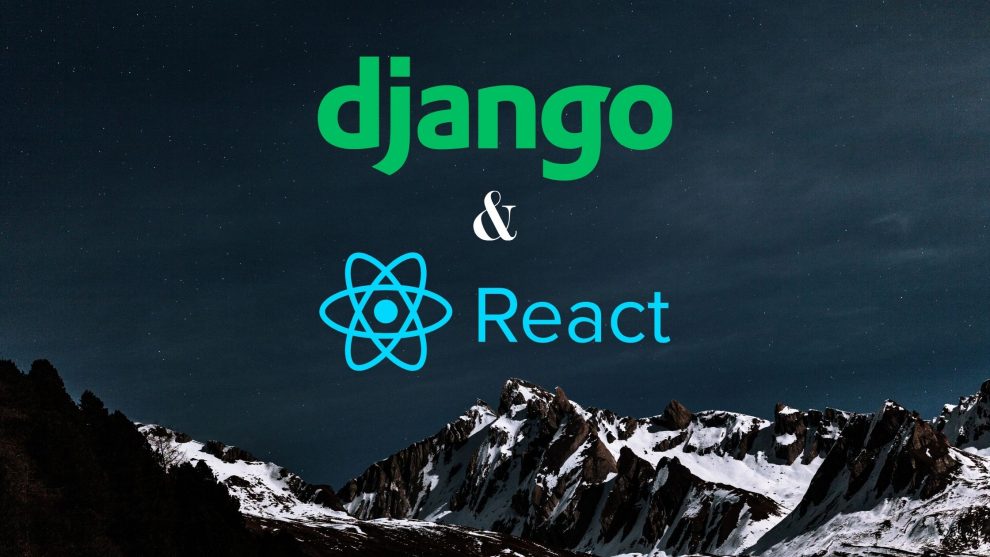In the realm of web development, pairing Django with React.js is a formidable combination that offers the best of both worlds. Django, a robust Python-based web framework, serves as the backend powerhouse, while React.js brings life to the front end with its dynamic and responsive capabilities. This guide will walk you through the process of connecting Django with React.js, resulting in a feature-rich and seamlessly integrated web application.
The Power of React.js
React.js, also known as React, is a JavaScript library developed and maintained by Facebook. It has taken the web development world by storm, thanks to its component-based architecture, which simplifies the construction of intricate user interfaces. Here’s why React.js is a prominent choice for front-end development
Component-Based Structure:
React’s modular components enable the building of UI elements that are easier to manage, reuse, and maintain.Virtual DOM:
React’s Virtual DOM efficiently updates only the components that have changed, optimizing rendering performance and ensuring a responsive user interface.Active Community:
With a thriving community, React offers extensive documentation, libraries, and resources, simplifying problem-solving and enhancing development.JSX:
React’s JSX syntax allows the seamless combination of JavaScript and HTML, making it more intuitive to create interactive UIs.One-Way Data Flow:
React enforces a unidirectional data flow, making it easier to debug and predict the behavior of your application.
The Versatility of Django
Django is a high-level Python web framework that has set the gold standard for back-end development. It offers an array of advantages that make it a top choice for building the server-side of your application
Built-In Admin Panel:
Django comes with a user-friendly admin panel for managing your application’s data, saving you from developing one from scratch.ORM (Object-Relational Mapping):
Django’s ORM simplifies database management, allowing you to work with your database using Python objects.Security:
Django incorporates various security features, such as protection against common web vulnerabilities, ensuring your application is robust and secure.Authentication and Authorization:
Django provides a robust authentication system and allows fine-grained control over user permissions.Scalability:
Django’s architecture enables the development of scalable and maintainable applications, making it a valuable choice for projects of any size.
Bridging the Gap: Django with React.js
The pairing of Django with React.js offers a wealth of benefits. Here are some compelling reasons to choose this combination for your web development journey
Full-Stack Capabilities:
With Django managing the back end and React.js handling the front end, you have all the tools you need for full-stack development within a single framework.Pythonic Synergy:
If you’re a Python enthusiast, Django’s integration with React.js allows you to leverage your Python skills across the entire application.Scalability and Performance:
Django’s performance and scalability, combined with React.js’s responsive user interfaces, create a potent mix for dynamic and efficient applications.Rich Ecosystem:
Both Django and React.js have extensive ecosystems, offering numerous packages, libraries, and extensions to simplify development.Ease of Maintenance:
Separating the back-end and front-end code facilitates easier maintenance and testing, making your application more robust.
Related: How to add theme to your React App
Connecting Django with React.js
Step 1: Setting Up the Backend with Django
In this step, you’ll create the Django backend for your application and set up the development server.
Create a Django Project
Open your terminal and navigate to the directory where you want to create your Django project. Run the following command, replacing ‘projectname‘ with your desired project name
django-admin startproject projectnameThis command initializes a Django project with the specified name.
Run the Development Server
Navigate to the newly created project directory
cd projectnameStart the Django development server
python manage.py runserverThis command launches the development server, and your Django application should now be accessible at http://localhost:8000.
Step 2: Creating the Frontend with React.js
Now, let’s create the React.js frontend within your Django project.
Create a React App
While inside your Django project directory, use Create React App to generate a new React.js app named ‘frontend‘
npx create-react-app frontendThis command sets up the React.js project within your Django project directory.
Start the React Development Server
Change your current working directory to the ‘frontend’ folder
cd frontendInitiate the React development server
npm startThe React app will start and be accessible at http://localhost:3000.
Step 3: Integrating the Frontend with Django
In this crucial step, you’ll ensure that the React.js frontend and Django backend communicate seamlessly.
Configure CORS (Cross-Origin Resource Sharing)
CORS allows your React front end, hosted on a different domain (typically http://localhost:3000), to interact with your Django back end (http://localhost:8000).
Install the “django-cors-headers” package
pip install django-cors-headersAdd ‘corsheaders’ to the INSTALLED_APPS list in your Django project’s settings (typically found in settings.py)
INSTALLED_APPS = [
# ...
'corsheaders',
]Configure CORS by adding the following settings to your Django project’s settings
MIDDLEWARE = [
# ...
'corsheaders.middleware.CorsMiddleware',
]
CORS_ALLOWED_ORIGINS = [
"http://localhost:3000", # Allow requests from your React app
]API Endpoints in Django
Create API endpoints in your Django project to serve data to the React front end. This involves defining Django views and setting up URL patterns.
In your Django ‘views.py‘, create a simple view that returns JSON data
from django.http import JsonResponse
def get_data(request):
data = {'message': 'This is data from Django.'}
return JsonResponse(data)In your Django ‘urls.py’, set up a URL pattern to route requests to this view
from django.urls import path
from . import views
urlpatterns = [
path('api/data/', views.get_data, name='get_data'),
]Fetching Data in React
In your React components, you can fetch data from your Django back end using the ‘fetch‘ API or a library like Axios. For example, you can create a component that fetches data from your Django API endpoint
import React, { useEffect, useState } from 'react';
function DataFetchingComponent() {
const [data, setData] = useState('');
useEffect(() => {
fetch('http://localhost:8000/api/data/')
.then((response) => response.json())
.then((data) => setData(data.message))
.catch((error) => console.error(error));
}, []);
return (
<div>
<p>Data from Django: {data}</p>
</div>
);
}
export default DataFetchingComponent;This completes the integration process, allowing your React.js front end to communicate with your Django back end. You now have the foundation for building a web application that combines the strengths of both technologies, creating a dynamic and interactive user experience.
Also Read: Create an App with React.js at the Front-end and Node.js at the Back-end
Step 4: Further Development and Deployment
Now that you’ve successfully connected Django with React.js, you can continue to develop your application. Add more views, models, and templates to your Django project, and enhance t e user interface and interactivity in your React.js front-end. Here’s how you can do that
Adding a New Django View and URL Mapping
You can add new views to your Django project for handling different functionalities. For example, let’s create a view to display a list of items from a database model.
# views.py
from django.shortcuts import render
from .models import Item
def item_list(request):
items = Item.objects.all()
return render(request, 'items/item_list.html', {'items': items})Don’t forget to create a corresponding URL pattern in your Django ‘urls.py’
# urls.py
from django.urls import path
from . import views
urlpatterns = [
# Your existing URL patterns
path('items/', views.item_list, name='item_list'),
]Fetching and Displaying Data in React
In your React.js front end, you can create components to fetch and display data from the Django back end. For example, you can create a component that lists items fetched from the Django API
// ItemList.js
import React, { useEffect, useState } from 'react';
function ItemList() {
const [items, setItems] = useState([]);
useEffect(() => {
fetch('http://localhost:8000/api/items/')
.then((response) => response.json())
.then((data) => setItems(data))
.catch((error) => console.error(error));
}, []);
return (
<div>
<h2>Item List</h2>
<ul>
{items.map((item) => (
<li key={item.id}>{item.name}</li>
))}
</ul>
</div>
);
}
export default ItemList;Deployment
When you’re ready to deploy your application, you have several options. Here are steps for deploying your Django back end and React front end separately on Heroku and Netlify
Deploying Django on Heroku
Sign up for a Heroku account and install the Heroku CLI
Create a Procfile in your Django project’s root directory with the following content
web: python manage.py runserver 0.0.0.0:$PORTInitialize a Git repository and commit your code
git init
git add .
git commit -m "Initial commit"Create a Heroku app and push your code to Heroku
heroku create
git push heroku masterMigrate your database on Heroku
heroku run python manage.py migrateDeploying React on Netlify
Sign up for a Netlify account and install the Netlify CLI.
Navigate to your React front-end project directory and build the project
Deploy the project to Netlify
npm run buildFollow the prompts and set up your deployment settings.
netlify deployThe deployed React app will be accessible via the provided Netlify URL.
These steps will allow you to continue enhancing and deploying your Django and React.js application, whether you’re adding new features to the back end or improving the user interface on the front end. Enjoy developing and deploying your web application!
Conclusion
In the world of web development, connecting Django with React.js brings a powerful synergy. Django takes care of the server-side complexity, while React.js crafts engaging and responsive user interfaces. This combination enables you to build a wide range of web applications, from simple prototypes to complex, data-driven platforms. So, embark on your Django-React.js journey and create applications that stand out in today’s competitive web development landscape. Happy coding!


























